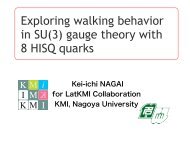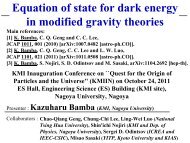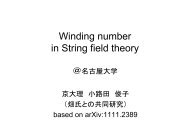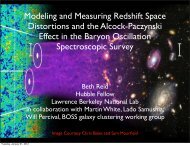Diego Saez-Gomez
Diego Saez-Gomez
Diego Saez-Gomez
You also want an ePaper? Increase the reach of your titles
YUMPU automatically turns print PDFs into web optimized ePapers that Google loves.
ere right lethand us remind side (r.h.s.). that T Thus, = T it µ = may ρ −lead 3p. toThe violations last equation of the usual differs evolution from theofusual different continuity species equation in theon th<br />
,-null T Nevertheless, ) mean rightdifferentiation hand in side the next (r.h.s.). with section Thus, respect<br />
F(R,T)<br />
we it focus may to Rour lead orattention T to , and violations<br />
gravity<br />
the on atensor model of theΘ that usual keeps evolution the usual of the continuity differentequation<br />
species in th<br />
µν is<br />
iverse. d. Nevertheless, in the next section we focus our attention on a model that keeps the usual continuity equatio<br />
hanged.<br />
δT αβ<br />
δg µν = −2T µν − g µν L m +2g αβ δL m<br />
. (4)<br />
III. δg µν<br />
f 1 g(R)+f αβ 2 (T ) TYPE THEORIES<br />
III. f 1 (R)+f 2 (T ) TYPE THEORIES<br />
section, absencewe of any choose kind the ofalgebraic matter, the function corresponding f(R, T ) to f(R) be agravity sum ofequations<br />
two independent functions<br />
nonding thisA section, particular properties wecase,<br />
choose and the thewell-known algebraic function solutionsf(R, for f(R) T ) togravity be a sum areof also two independent functions<br />
acuum (for a review on f(R) theories, f(R, T see )=f [1]). 1 (R)+f Moreover, 2 (T ) here we are<br />
d of theories for spatially flat FLRW spacetimes, f(R, T )=f which 1 (R)+f are expressed 2 (T ) in<br />
(12)<br />
(12<br />
(R) and f 2 (T ), respectively depend on the curvature R and the trace T . The generalized Einstein equations<br />
ere rgy<br />
yield fdensity, Friedmann<br />
1 (R) andwith f<br />
equations,<br />
2 (T ), respectively depend on the curvature R and the trace T . The generalized Einstein equation<br />
(8) ds 2 yield = a 2 (η) f 10 ≡ f 1 (R 0 ), f 1R0 ≡ df 1 (R 0 )/dR 0 , f 20 ≡ f 2 (T 0 ), f 2T0 ≡ df 2 (T 0 )/dT 0 and c 2<br />
dη 2 − dx 2 s = p 0 /ρ 0 . Th<br />
tinuity equation (11) for Lagrangians given by (12) yields<br />
(5)<br />
<br />
− 3Hf 1R +3H f 1R0 − a2<br />
2 f <br />
<br />
10 = −κ 2 a 2 ρ 0 +(1+c 2 s)ρ 0 a 2 f 2T0 + a2<br />
l time η. Then, the main ∇ 2 f 20 , (13)<br />
− 3Hf 1R 0<br />
+3H f 1R0 − a2<br />
f <br />
1R 0<br />
+ Hf 1R 0<br />
− (H +2H 2 )f 1R0 + a2<br />
2 f 2 f 10 = −κ 2 a 2 ρ 0 +(1+c 2 s)ρ 0 a 2 f 2T0 + a2<br />
µ T µ issue arises on the content of the Universe is<br />
0 ν = 1<br />
1<br />
10 = −κ 2 2 c 2 sρ 0 − a2<br />
2 f 2 f 20 , (13<br />
ensor, defined in (2). Since we are κ 2 δ ν µ ∂ µ<br />
−interested f 2T0 on flat 2 f 20 + c 2 sρ 0 f 2T0 + T µ<br />
0 ν ∂ µf 2T0 , (15<br />
FLRW cosmologies,<br />
less matter, radiation,... ) can be well described 20 . (14)<br />
f <br />
1R 0<br />
+ Hf 1R 0<br />
− (H +2H 2 )f 1R0 + a2 by<br />
2 f perfect fluids, whose<br />
wing explicitly that the energy-momentum tensor is not<br />
10 = a priori −κ 2 a 2 covariantly c 2 sρ 0 − a2<br />
2 f conserved<br />
20 . in f(R, T ) theories. Thus (14<br />
these theories, the test particles moving in a gravitational<br />
e prime holds for the derivative with respect to η, H ≡ a field do not follow geodesic lines. By exploring th<br />
ation /a and the subscript 0 holds for unperturbed<br />
ere ndT (15)<br />
quantities: the prime Rholds 0 denotes for the thederivative scalar curvature with respect corresponding to η, Hto ≡the a µν =(ρ<br />
for<br />
+ p)u<br />
ν =<br />
µ u<br />
0 component,<br />
ν − pg µν .<br />
one gets<br />
Continuity equation,<br />
/a unperturbed and (6) the subscript metric, ρ0 holds the unperturbed for unperturbe<br />
kground quantities: R 0 denotes the scalar curvature corresponding to the unperturbed metric, ρ 0 the unperturbe<br />
ρ 0 +3Hρ 0 (1 + c 2 1<br />
s)=<br />
κ 2 (1 + c 2<br />
− f<br />
s)ρ 0 f2T 0<br />
+ c 2 sρ 0f 2T0 + 1 <br />
2T0<br />
2 f 20<br />
. (16<br />
e that The whether usual continuity f 2 vanishes equation (i.e., is f(R) recovered theories) when, or characterizes a non-running cosmological constant, both f 2T<br />
vanish, and then the continuity equation in these scenarios becomes<br />
f 2T0<br />
f<br />
ρ 0 +3H 2 (T )=α √ 1+c 2 T + β<br />
s<br />
ρ0 =0 . (17<br />
n order to Lagrangians such as (12) consistent with the standard conservation equation, the r.h.s. of (15) has t<br />
ish leading to the differential equation<br />
1 <br />
F. Alvarenga, A. Cruz-Dombriz, S. Houndjo, M. Rodrigues, DSG, to appear in PRD, ArXiv:1302.1866










